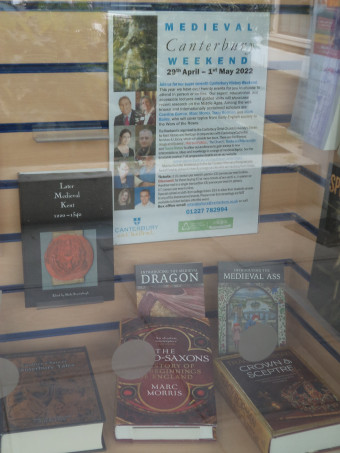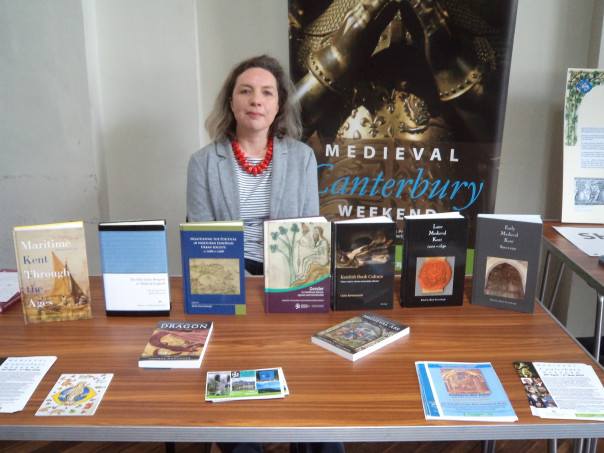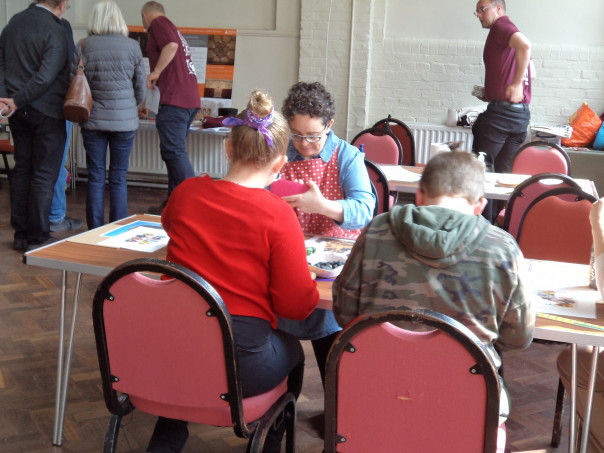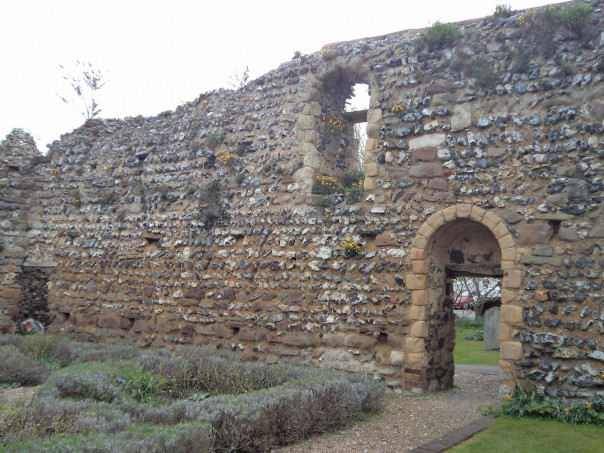I thought I would start by saying that we are now on the countdown to the Medieval Canterbury Weekend 2022 and, for those who use twitter, Dr Diane Heath informs me that it would be great if people used #MCW22 and much appreciated. Tickets for the Weekend are still available at www.canterbury.ac.uk/medieval-canterbury and we will have a temporary box office on campus on the Saturday in Touchdown next to the CCCU Bookshop’s special Weekend bookstall. So please do come along if you can, we would be delighted to see you.

Keeping with Diane but turning to her Lottery Funded ‘Medieval Animals Heritage’, many congratulations because she and Penny Bernard have been awarded £7,900 by KCC for a series of drama workshops, including a performance, of a Becket Medieval Mystery Play for SEND children. These will take place over a week in early August in Sandwich Guildhall. Furthermore, Diane will get to build her green moss dragon in St Martin’s Priory gardens! This is part of an Historic England grant through CCCU’s Deep Education and Community Action project, and Diane will also get the St Augustine’s Abbey herbal facsimile scanned for good measure.
Now for this week I’ll give a brief report on the University of Kent’s IHR Centenary event, as well as alerting you to Christ Church’s contribution to this nationwide celebration of historical research and outreach through the auspices of the Institute for Historical Research (IHR). This latter project was led by Dr Claire Bartram, and it has given us, through Matthew Crockatt, an opportunity to try out a different format on the Centre’s blog. For those of you who haven’t seen the splendid result, please explore here: https://blogs.canterbury.ac.uk/kenthistory/imagining-dover/ and do send us your comments. Similarly, if it inspires you to want to write something about Dover or in response to what is here, please do because Claire would be delighted to hear from you.

Moreover, this week both Claire and I organised group visits to Canterbury Cathedral Archives. Claire took her third-year undergraduates who have been looking at the development of print and book culture over the 16th and 17th centuries and how the narrative of the move from manuscript to print actually took place. As Claire wanted them to understand, this is not a simple process and Canterbury is especially interesting due to the presence of a local printer who was operating from the latter part of Henry VIII’s reign in St Paul’s parish.
Her group had a great time and similarly my MEMS MA palaeography cohort seemed to enjoy exploring a range of civic documents, as well as medieval churchwardens’ accounts from Sandwich. This latter volume is a favourite of mine being a great early set of accounts from the mid 15th century from St Mary’s parish having been produced in response, as it says, to the theft of the book by the French raiders on the town amongst other things that they took. Incidentally the town’s mayor was killed during the raid, and this is still remembered through the black arm band that mayors continue to wear to denote this incident. But back to the accounts, as the postgraduates discovered, the churchwardens were not only writing in English at this early date but made considerable use of two runes the ‘thorn’ and the ‘yogh’. The ‘thorn’ has come down to use today as the ‘ye old tea shop’, a fascinating leftover of early English language and culture.

So now back to Professor Mark Connelly’s ‘Kent: Gateway to the World History Festival’ in the Westgate Hall, and incidentally the second instalment will be this coming Saturday at the Royal Engineers Museum in Gillingham if you fancy that. As at Canterbury you can book in advance through Eventbrite, but equally feel free to go along on the day although there will be an entrance fee if not pre-booked at Gillingham.
I haven’t been in the Westgate Hall for some while and this pretty central location in Canterbury meant that as well as people who had booked, there were people who happened to be passing who then came in to see what was happening. To be honest, lots was taking place from the stalls of different organisations, tables laid out with exciting child-friendly activities and a space for the various talks taking place in the morning session on ‘Kent, the sea, ships and boats’ and for the afternoon on ‘Pilgrims, migrants and visitors’. For example, the Centre’s stall was between that of Shepherd Neame from Faversham, ‘Britain’s oldest brewer’ and the Whitstable Community Museum and Gallery. Also there was the Faversham Society Archaeological Research Group; the Historical Association, Canterbury branch; the Dover Maison Dieu, in part staffed by two CCCU students Kate and Leo, and several other groups who provided speakers. This meant Claire and I (Diane was away on a field trip in the West Country) had the chance to meet up with people we know from these different organisations, meet new people and find out about their activities, such as the increasing number of historic boats found offshore along the Whitstable-Tankerton coastline, and the growing number of finds from the Faversham creek area, including skeletal remains.

It was also great to meet members of the public who had come to find out about the history and heritage of Canterbury and east Kent, and this included some families, the children taking advantage of Penny Bernard’s ‘Medieval Animals Heritage’ and the Dover Maison Dieu’s creative activities, leaving their parents to join the audience nearby for the presentations.
Mark Connelly did a great job throughout the day introducing the two sessions and the various speakers, as well as chairing the two panels for Q&A. For the morning we moved from prehistory and the Dover Bronze Age boat to the long career of a clipper ship captain called William Harrison, who has been described as “one of the most experienced and respected deep sea sailing skippers … a master of his profession.” In between we heard from Anthony Millett, a long-standing tour guide from Faversham, who provided an entertaining and colourful history of the town using the topics, boats, bricks and beer.
For the Bronze Age boat, Martin Crowther explained just how difficult the archaeological excavation had been to work on even a section of the boat in 1992, but this had been an amazing discovery which has resulted in a fascinating book, published by Canterbury Archaeological Trust, and the building of a half-size reconstruction as part of an experimental archaeological project. Although this replica has not been tried on a Channel crossing, it has been paddled out from Dover harbour and a crew has taken part in the Great River Race on the Thames. Furthermore, there is an excellent display featuring the Bronze Age boat at Dover Museum.

Stuart Bligh, until recently at the Royal Museums Greenwich, has been researching the life and career of Captain Harrison who died at sea on a return voyage from Australia in 1888 having rounded Cape Horn and though very ill survived until his ship, the Ascalon, was just north of the equator in the mid-Atlantic. He left a wife and 5 children and had spent about half a century sailing the oceans, part of Britain’s exceedingly vital merchant navy.
The afternoon session was again opened by Martin who, as the Maison Dieu Engagement Officer, provided a ‘tour’ of this fascinating building and highlighted the recent finds from an archaeological excavation there. This has resulted in the finding of several pieces of medieval stained glass. Both Leonie Seliger from Canterbury Cathedral’s Stained Glass Studio and Professor Richard Marks from the University of York have been consulted and they think the glass dates from the late 13th century, which fits with the dating of this part of the building.
We then moved to exploring the lives of those from overseas who had settled in 15th-century Canterbury and set up business there. I’ll be using a much longer version of this for my article in the next Kent Archaeological Society’s volume, ‘Migration in Kent’ so for now I’ll just mention a little about one of these immigrants. Gylkyn Goodknyght seems to have been in Canterbury by 1463 when he was picked up by the royal clerk who recorded the presence of a Gilderkyn Ducheman and two years later a Gilderkyn Goodknyght. What he was doing is not clear but from 1472 for several years he did have his own business as a cap maker, although in the final year that we know about in 1478 it was his widow who paid the licence fee. Even though this is not much more than a snapshot, it does demonstrate how different types of record can be brought together to offer a glimpse into the lives of those normally lost from sight in the search for ‘history from below’.

Keeping with the Middle Ages, Cressida Williams from Canterbury Cathedral Archives explored pilgrims and medieval Canterbury and then we shot forward in time to Hazel Basford’s (from the Western Front Association) examination of the history of Quex Park as a VAD hospital during WWI and the lives of some of the patients who passed through its doors. Hazel was followed by Mady Beardmore who highlighted the very recent opening of The Kent Mining Museum based on the former Betteshanger Colliery site. For her presentation she looked at the places Kent miners had come from and among the topics she discussed was how they had been received by the local population. The final presentation was given by Sarah Nathaniel of The Commonwealth War Graves Commission who showed her audience how the Commission operated and just how many different nationalities are commemorated in Kent in this way.
As Mark said in his closing remarks, it had been a fascinating day that demonstrated just how significant the county has been as a crossroads for people, goods and ideas throughout the centuries, and that by studying this history we can get insights that resonate with today, and presumably into the future.
 Centre for Kent History and Heritage
Centre for Kent History and Heritage Sheila Sweetinburgh
Sheila Sweetinburgh 1150
1150

